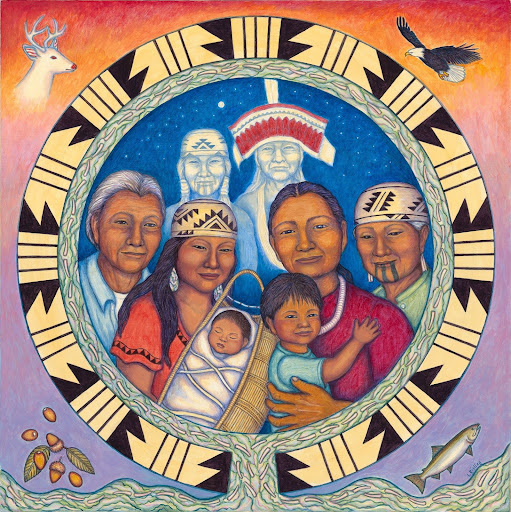Overview
We are Still Here: Notice Wonder Feel

Authors and Collaborators:
Maggie Peters, Yurok/Karuk Educator, Traditional Basket Weaver, Cultural Preservationist, Native American Studies Model Curriculum Learning Specialist at Humboldt County Office of Education
Lyn Risling, Karuk/Yurok/Hupa Artist, Author, Illustrator, Ceremonial Leader
Julian Lang, Karuk Linguist, Artist
- Video support provided by Joanna Galicha, Graphics & Communications Specialist at Humboldt County Office of Education
We Are Still Here, Fix the World People Unit (Lesson 1 of 6)
- Lesson 1: Notice Wonder Feel
- Lesson 2: Lyn Risling, Karuk, Hupa, and Yurok Artist
- Lesson 3: History and Survival
- Lesson 4: Resilience and Healing
- Lesson 5: Ararachúupha Nuu Payêem Nuchúuphitih (We Are Talking Our Indian Language Now)
- Lesson 6: Expression of Self - Art Inspired by Lyn Risling
Grade: 7
Suggested Amount of Time: 55- 60 minutes (designed for multi-period schedule typical of middle schools)
Curriculum Themes
- History
- Cultural Strengths
- Relationship to Place
- Cross Curricular Integration
Learning Goals
- Observe, interpret and ask questions about art using the Notice Wonder technique.
- Critically analyze new information with curiosity and express thoughts.
- Identify culturally significant resources of the Karuk People.
Lesson Overview
In this lesson, students will engage with the artwork "We Are Still Here, Fix the World People" by Lyn Risling, an artist from the Karuk, Hupa, and Yurok peoples of northwestern California. The painting reflects the strong connection these Indigenous communities have with the land, culture, and their ancestors, showcasing themes of resilience, survival, and cultural identity after colonization in the 1860s.
The artwork features a vibrant background with a gradient of red to purple, reminiscent of a sunset or sunrise. In the center, there is a multigenerational family surrounded by images of ancestors in traditional "Fix the World" regalia. The family is encircled by a round border representing a river filled with dentalia shells, framed by a black and tan basket design. Other symbolic elements, like a white deer, an eagle, acorns, and a salmon, are placed in the corners, each carrying cultural significance.
This lesson uses the "Notice, Wonder, Feel" strategy to guide students through their exploration of the painting. By focusing on what they notice about the artwork, what questions arise, and how they feel in response, students will gain a deeper understanding of the cultural symbols and the powerful narrative Lyn Risling is conveying through her art.
The purpose of the lesson is not only to appreciate the aesthetic beauty of the piece but to also connect with its deeper meaning: the ongoing presence and cultural vitality of Native American communities, particularly the Karuk, Hupa, and Yurok tribes. Through this strategy, students will develop their observational and reflective thinking skills while learning about the significance of heritage, family, and resilience.
As you guide the students through the "Notice, Wonder, Feel" process, encourage them to think critically and emotionally about the painting. Provide opportunities for them to ask questions and share their feelings, helping them connect the symbolism in the artwork to broader themes of cultural survival and connection to the land. This will not only enhance their understanding of the painting itself but also foster a greater respect for Indigenous traditions and histories.
Teacher Background
This unit centers on the powerful artwork of Lyn Risling, Karuk, Yurok, and Hupa Artist from northwestern California, whose work vividly reflects the resilience, survival, and cultural identity of these Indigenous communities. Her artwork, particularly her painting, We Are Still Here, Fix the World People, draws from her deep connections to her heritage and the enduring strength of her people. As a contemporary artist and ceremonial leader, Risling's art provides a lens through which students can explore themes of cultural preservation, the impact of colonization, and the role of art in community healing.

